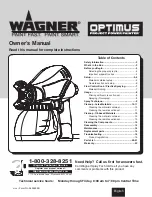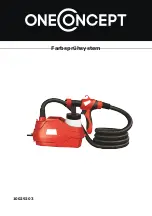
1) Thoroughly mix paint to be sprayed in accordance with the manufacturer’s instructions,
adding thinner where necessary.
2) Strain material through 60 to 90 mesh screen.
3) Fill the paint cup about 3/4 full and attach to paint gun securely.
4) Attach air supply to 1/4” NPS inlet.
NEVER point spray gun at self or others. Accidental discharge of
material may result in serious injury.
5) Start the air compressor
6) Adjust air pressure via air supply regulator
DO NOT Exceed 100 psi.
7) Prepare a piece of scrap material for use as a spray gun test target.
8) Depress spray gun trigger fully to spray material.
NOTE: Depressing trigger partially will cause only air to be released.
9) Adjust the air pressure and paint flow to provide a uniform dispersion of atomized paint
throughout the pattern. Keep air pressure as low as possible to minimize paint “bounce back”
and overspray. Excessive fluid flow will result in a heavy center spray pattern. Inadequate
flows will cause the spray pattern to split. Please see the Troubleshooting section of this guide
if any problems occur.
10
11
PREPARATION FOR SPRAYING
FAN DIRECTION
DO NOT ATTEMPT TO UNCLOG (BACK FLUSH) SPRAY GUN BY
SQUEEZING TRIGGER WHILE HOLDING FINGER IN FRONT OF FLUID
NOZZLE.
Pressure may vary according to viscosity of material used.
Maximum
working pressure of this gun is 100 psi. DO NOT EXCEED PRESSURE LIMIT
OF GUN OR ANY COMPONENT IN THE SYSTEM.
Prior to daily operation, make certain that all connections and fittings
are secure.
Check hose and all connections for weak or work conditions
that could render the system unsafe.
All replacement components must have a working pressure equal or
greater than the system pressure.
This spray gun was treated with an anticorrosive agent prior to
shipment.
CAREFULLY FLUSH GUN WITH THINNER BEFORE USE.
The position of the air cap horns determines the directions of the
fan (horizontal or vertical spray pattern). Loosen the lock ring on
the air cap and rotate the horns to achieve the desired pattern.
Hand tighten lock ring after adjustment.
WATER AND/OR OIL IN COMPRESSED AIR
All compressor pumps discharge some condensed water, oil or contaminates with the
compressed air. IMPORTANT: This condensation will cause “fish eyes” to appear in the paint
job. Install appropriate water/oil removal filter equipment and controls as necessary for the
intended application.
Failure to install appropriate water/oil removal equipment may result in
damage to machinery or work piece.
SIPHON AND GRAVITY FEED GUNS
1) Adjust air pressure to the spray gun according to the
recommendations supplied by the spray material manufacturer.
This air pressure is typically below 20 psi for HVLP spray guns
and between 40 to 60 psi for conventional spray guns. Adjust
air pressure with the trigger pulled and the air control knob (if
applicable) fully open.
2) The width of the “fan spray” is controlled by the pattern control
knob. Turn knob counterclockwise to increase the width of the
fan spray pattern. Turn knob clockwise to decrease the spread
of the fan spray pattern for a round pattern.
3) Trigger a short burst while turning fluid control knob until the
desired pattern on the test target and adjust the fluid control
knob until the desired atomization (spray) pattern is achieved.
If the spray is too fine, creating excessive overspray, there is
too much air for the amount of paint being sprayed – Reduce
the air pressure or open the fluid control to spray more
material. If the spray is too coarse, (spitting globs of paint),
reduce the amount of material with the fluid control knob or
thin the paint.
SPRAY PATTERN ADJUSTMENT
Содержание 19220
Страница 12: ...22 23 NOTES NOTES ...































